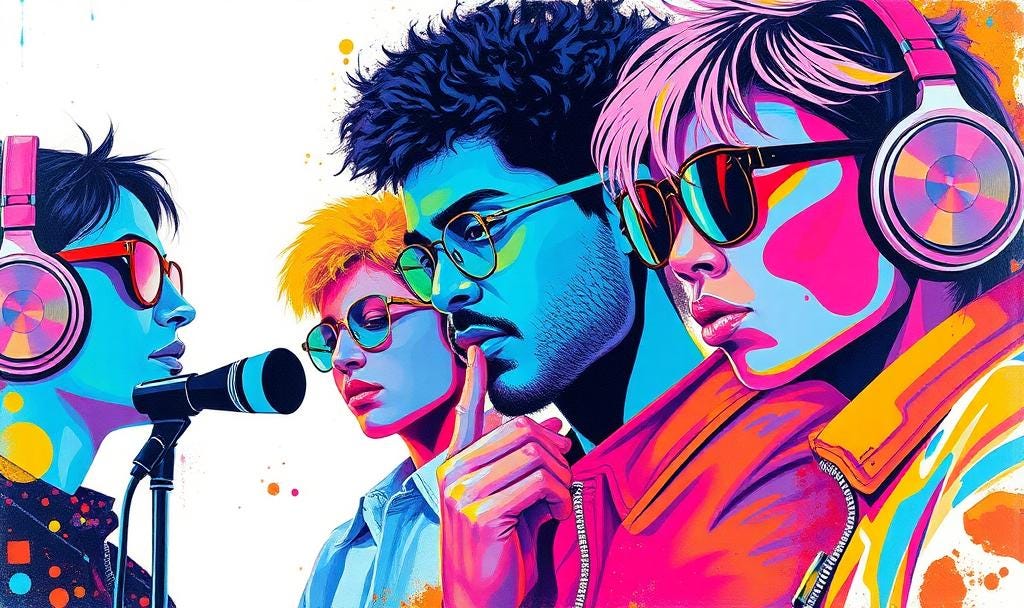Dance & Electronic Music’s Early Rise
This is part of my Pop Music in the ‘80s series.
The Beat That Wouldn’t Stop
While pop stars filled arenas and MTV transformed the way millions of Americans consumed rock and pop music, another revolution was quietly building in the shadows of America’s urban nightlife. DJs and producers were crafting something new in the clubs of Chicago, Detroit, and New York: Electronic Music. This was a music built for the dancefloor, shaped by machines, and sustained by community. The sound was raw, repetitive, and electrifying. It didn’t rely on major labels or radio play. It relied on movement.
From warehouse parties to underground raves, the rise of house, techno, and 9+ in the 1980s laid the foundation for global dance culture. These genres innovations in sound. They were expressions of identity, resistance, and joy in marginalized communities. In this lesson, we explore the early rise of electronic and dance music, tracing its evolution from DIY scenes to lasting global impact.
Chicago’s House Music Revolution
House music emerged in Chicago’s Black and Latin gay clubs, with DJ Frankie Knuckles at the center of the storm. At venues like the Warehouse (which gave the genre its name), Knuckles mixed disco, soul, and European electronic music into extended dancefloor journeys. With drum machines like the Roland TR-808 and synthesizers like the TB-303, producers could now create full tracks without live bands. This was further explored, as digital technology rapidly improved in the early decade and far more advanced synthesizers quickly flooded the markets.
Tracks like Jesse Saunders’ “On and On” (1984) and Marshall Jefferson’s “Move Your Body” (1986) became underground anthems, passed around on cassette and vinyl long before they hit mainstream consciousness.
Detroit’s Futuristic Blueprint
While house music celebrated soulful grooves, Detroit techno brought a colder, more mechanical edge. Pioneers like the Belleville Three (Juan Atkins, Derrick May, and Kevin Saunderson) fused funk, Kraftwerk, and Afrofuturist ideals into a sound that imagined the future through machines.
Atkins’ band Cybotron had a synthetic precision that would influence electronic music worldwide (especially evident in the track “Clear” from the group’s debut album Enter). Techno, with its pulsing loops and stark textures, was a vision of Black creativity navigating the industrial collapse of Detroit, and transcending it.
Freestyle and Latin Innovation in New York
Alongside house and techno, freestyle music took root in New York. A blend of electronic sounds, Latin rhythms, and streetwise pop, freestyle was driven by young Latin-American artists and producers. Acts like Lisa Lisa & Cult Jam, Exposé, and Stevie B brought emotional vocals and syncopated synths to the radio.
Of the three genres discussed so far, freestyle had the broadest commercial appeal. Songs like “Let the Music Play” by Shannon (1983) and “Show Me” by The Cover Girls (1986) crossed over into mainstream charts, even as the genre remained closely tied to dance clubs and regional fanbases. Freestyle was a distinctly urban artform that was glossy yet grassroots and catchy yet cutting-edge.
DIY Ethos and Underground Networks
These early dance genres were united by the use of electronics, but also the overarching underground spirit. Independent labels, pirate radio, and record store culture all helped spread the music. These were scenes that thrived without major-label backing or mass media exposure. The ethos was: make it yourself, share it with your community, and keep the party going.
Dance music was inclusive, often centered around queer and minority spaces, offering refuge and expression. The clubs were sanctuaries, and for many, the music was a sort of liberation in 4/4 time.
From the Ashes of Disco, A New Pulse
The rise of electronic dance music in the early ’80s cannot be separated from the fall of disco in the late ‘70s. When disco was pushed out of the mainstream, vilified by critics, mocked by rock radio, and even burned in protest, it didn’t disappear. It went underground. It morphed into something leaner, rawer, and more rebellious. The DJs who once spun extended disco cuts in clubs like Studio 54 or The Paradise Garage found new homes in Chicago’s Warehouse, Detroit’s Music Institute, and New York’s Latin freestyle parties.
These were new movements in new venues, but they were also an evolution of what had come before. Armed with drum machines and a DIY ethos, creators built tracks from scratch, programmed rhythms by hand, and sampled liberally from funk, soul, and Kraftwerk. Afrika Bambaataa and the Soulsonic Force’s track “Planet Rock” was a shocking conundrum. It was Bronx street beats, it German Kraftwerk-style synths, and it was motored by the infectious drive of the TR-808. Even the music video for “Planet Rock”, signaled a very digital future. And change was coming to broader mainstream music too, but this time not just on the dancefloor, the way music was created, recorded, and distributed was transforming throughout the decade.
The Music Industry Remixes Itself
As electronic music scenes pulsed in basements and warehouses, the broader music industry faced a seismic shift of its own. A new digital format was on the rise, threatening to upend how music was made, sold, and heard. The compact disc (CD) promised crystal-clear sound, endless reissues, and new profits. The CD created a new (and lucrative) thirst for back catalogs and it altered listening habits forever.
In our next lesson, we’ll explore how the CD era and the business moves behind it reshaped pop music in the ’80s and paved the way for a new era of media-driven music empires.





